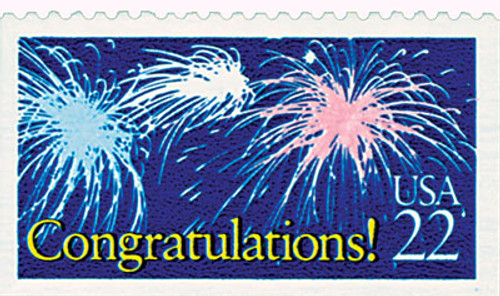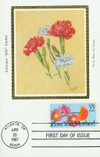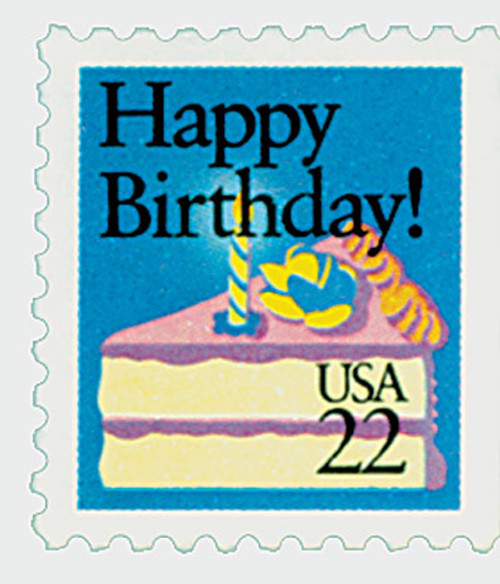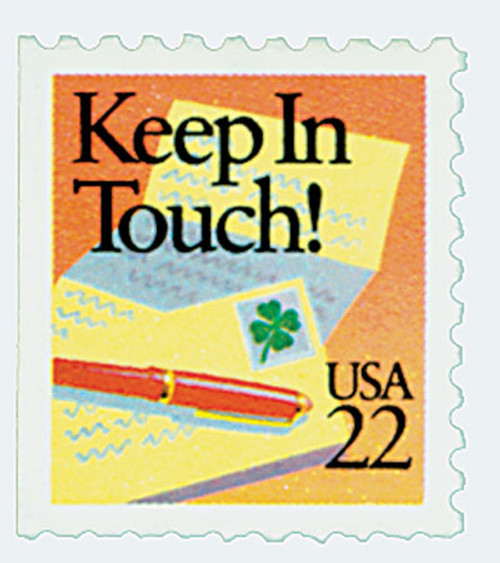
# 2273 - 1987 22c Special Occasions: Love you, Mother!
U.S. #2273
1987 22¢ Love You, Mother!
Special Occasions
- From first “special” stamp booklet, which would remain on sale longer than regular stamps
- From first US booklet to have the UPC bar code on the cover
- First US stamps to be specifically created for a specialized retail market and sold through card stores and florists
- From first US booklet to have stamps in three different configurations.
Stamp Category: Commemorative
Set: Special Occasions
Value: 22¢, first-class rate
First Day of Issue: April 20, 1987
First Day City: Atlanta, Georgia
Quantity Issued: 76,303,125
Printed by: Bureau of Engraving and Printing
Printing Method: Photogravure
Format: Booklet panes of 10
Perforations: 10 on 1, 2, or 3 sides
Why the stamp was issued: In response to calls for stamps that could frank mail for special occasions.
About the stamp design: The Special Occasions stamps were the first to be designed by Oren Sherman. He produced the designs based on messages provided by the Citizens’ Stamp Advisory Committee and the USPS. This stamp reads “Love You, Mother!” with Gerber daisies.
First Day City: During the planning process for these stamps, the USPS talked extensively about issuing them in May 1987 at the New York City trade show of a stationers’ group. However, as the date drew nearer, they realized that the trade show would take place after Mother’s Day, and with one of the stamps ideal for that holiday, they wanted to issue the booklet beforehand. So instead, they moved the ceremony to Atlanta, Georgia on April 20, 1987. Among those present for the ceremony was Martha Burke, National American Mother of the Year.
About the Special Occasions Set: For several years, the USPS received requests for stamps for special occasions such as Mother’s Day, Father’s Day, weddings, graduations, birthdays, and more. In the mid-1980s, the USPS began addressing these requests.
The Special Occasions booklet began with a single stamp. In 1985, the USPS announced it would issue a stamp to mark the 50th anniversary of American Mothers, Inc. in 1986. However, as they discussed the stamp and the public requests further, the idea grew into what they called the Messages booklet, and later the Special Occasions booklet.
As the USPS moved forward with the project, they did something they hadn’t done before. They started working with florists and the greeting card industry, trying to see if they would be interested in seeing these new stamps in their stores. The USPS encouraged them to poll their respective associations. They wanted to know if there would be interest in selling these stamps in their stores. If successful, the Special Occasions stamps could be sold in stationery stores, card shops, large supermarkets, and other non-postal outlets. And if the stamps were popular enough, they could be as big for the USPS as Love and Christmas stamps.
In September 1986, the final eight stamp designs were revealed at a meeting of the Greeting Card Association. It was announced that the booklets would have 10 stamps, with two of the designs (Congratulations and Happy Birthday) being repeated, selling for a total of $2.20. This was also the first US booklet to have the UPC (Universal Product Code) bar code on the cover.
When the stamps were released, the USPS said that they “classified them as special stamps because they would remain on sale longer than commemorative stamps.” The stamps were to remain on sale for the remainder of the year, making them the USPS’s first “special” stamp booklet. They were the first US stamps to be specifically created for a specialized retail market, the first to be sold through card stores and florists, and the first US booklet to have stamps in three different configurations.
History the stamp represents: Greeting cards date back to the ancient Chinese, who sent messages celebrating the New Year and the early Egyptians who sent messages on papyrus scrolls. Handmade greeting cards grew in popularity in Europe in the 1400s. For many years, greeting cards were expensive, but advancements in printing technology and the advent of postage stamps made sending the cards more affordable by the 1850s. Soon cards could be mass produced for occasions throughout the year.
Hallmark Cards, Inc., one of America’s largest greeting card manufacturers, was founded in 1910 by Joyce C. Hall. Previously, Hall had owned a small retail store, but after a captivating conversation with a travelling salesman, he narrowed his focus on postcards. Hall soon recognized that greeting cards would become more popular than postcards. He believed greeting cards “represented class, promised discretion and… were more than a form of communication – they were a social custom.”
History of Mother’s Day
On May 10, 1908, the first official Mother’s Day celebration was held in Grafton, West Virginia.
In the 1800s, many women’s groups worked to create holidays to promote peace, including special meetings of mothers whose sons had fought or died on opposing sides of the Civil War. In 1868, Ann Jarvis formed a committee to create a Mother’s Friendship Day “to reunite families that had been divided during the Civil War.”
Previously, Jarvis had also created Mother’s Day Work Clubs to promote more sanitary conditions for Union and Confederate soldiers suffering from a typhoid outbreak. Jarvis hoped to create an annual holiday to celebrate mothers. In the late 1800s, there were lots of specialized celebrations, such as Children’s Day, Temperance Sunday, Roll Call Day, Decision Day, and Missionary Day. On June 2, 1872, Julia Ward Howe held a Mother’s Day for Peace anti-war demonstration and made an “appeal to womanhood throughout the world.” Howe led similar observances in Boston for about 10 years, but they eventually stopped.
Another early observance came on May 13, 1877, in Albion, Michigan. At the time, it was reported that three temperance advocates were forced at gunpoint to spend a night in a saloon and become drunk. After hearing of this, Juliet Calhoun Blakeley addressed the congregants of a local church and urged mothers to join her temperance cause. Her sons, who were traveling salesmen, were moved by their mother’s speech and promised to return home every year to honor her, as well as convince their business contacts to do the same. By the early 1880s, the Methodist Episcopal Church in Albion had set aside the second Sunday in May to honor mothers.
However, none of these celebrations caught on nationwide. Anna Jarvis, daughter of Ann Jarvis, is often credited as the founder of Mother’s Day. After her mother died in 1905, Anna became even more dedicated to establishing an official Mother’s Day observance. On May 12, 1907, she held a small service at Andrew’s Methodist Episcopal Church in Grafton, West Virginia, where her mother had taught Sunday school. Then the following year she staged what’s recognized as the first official Mother’s Day, on May 10, 1908. The celebration included a church service as well as a larger ceremony at the Wanamaker Auditorium in Philadelphia. By the following year, Mother’s Day was being celebrated in New York.
From there, Jarvis wanted to make Mother’s Day a US holiday, and eventually an international holiday. In 1910, West Virginia declared it an official holiday, and other states quickly followed. Then in 1913, the House of Representatives called on the president and all federal officials to wear white carnations on May 11 to honor Mother’s Day.
On May 8, 1914, Congress passed a law establishing the second Sunday in May as Mother’s Day. The next day, President Woodrow Wilson issued an official proclamation declaring the first Mother’s Day. The proclamation called for Americans to hang their flags to honor the mothers whose sons had died in a war.
Though she had succeeded in her goal, Jarvis grew upset in the coming years over the commercialization of Mother’s Day. She objected to companies, such as Hallmark Cards, making a profit, and encouraged people to write handwritten letters rather than buy gifts. She even protested at a candy makers convention and a meeting of the American War Mothers, who sold carnations on Mother’s Day. Years later, the church in Grafton, West Virginia was incorporated as the International Mother’s Day Shrine and declared a National Historic Landmark. Today, most countries celebrate Mother’s Day, though not all on the second Sunday of May as we do in the US.
U.S. #2273
1987 22¢ Love You, Mother!
Special Occasions
- From first “special” stamp booklet, which would remain on sale longer than regular stamps
- From first US booklet to have the UPC bar code on the cover
- First US stamps to be specifically created for a specialized retail market and sold through card stores and florists
- From first US booklet to have stamps in three different configurations.
Stamp Category: Commemorative
Set: Special Occasions
Value: 22¢, first-class rate
First Day of Issue: April 20, 1987
First Day City: Atlanta, Georgia
Quantity Issued: 76,303,125
Printed by: Bureau of Engraving and Printing
Printing Method: Photogravure
Format: Booklet panes of 10
Perforations: 10 on 1, 2, or 3 sides
Why the stamp was issued: In response to calls for stamps that could frank mail for special occasions.
About the stamp design: The Special Occasions stamps were the first to be designed by Oren Sherman. He produced the designs based on messages provided by the Citizens’ Stamp Advisory Committee and the USPS. This stamp reads “Love You, Mother!” with Gerber daisies.
First Day City: During the planning process for these stamps, the USPS talked extensively about issuing them in May 1987 at the New York City trade show of a stationers’ group. However, as the date drew nearer, they realized that the trade show would take place after Mother’s Day, and with one of the stamps ideal for that holiday, they wanted to issue the booklet beforehand. So instead, they moved the ceremony to Atlanta, Georgia on April 20, 1987. Among those present for the ceremony was Martha Burke, National American Mother of the Year.
About the Special Occasions Set: For several years, the USPS received requests for stamps for special occasions such as Mother’s Day, Father’s Day, weddings, graduations, birthdays, and more. In the mid-1980s, the USPS began addressing these requests.
The Special Occasions booklet began with a single stamp. In 1985, the USPS announced it would issue a stamp to mark the 50th anniversary of American Mothers, Inc. in 1986. However, as they discussed the stamp and the public requests further, the idea grew into what they called the Messages booklet, and later the Special Occasions booklet.
As the USPS moved forward with the project, they did something they hadn’t done before. They started working with florists and the greeting card industry, trying to see if they would be interested in seeing these new stamps in their stores. The USPS encouraged them to poll their respective associations. They wanted to know if there would be interest in selling these stamps in their stores. If successful, the Special Occasions stamps could be sold in stationery stores, card shops, large supermarkets, and other non-postal outlets. And if the stamps were popular enough, they could be as big for the USPS as Love and Christmas stamps.
In September 1986, the final eight stamp designs were revealed at a meeting of the Greeting Card Association. It was announced that the booklets would have 10 stamps, with two of the designs (Congratulations and Happy Birthday) being repeated, selling for a total of $2.20. This was also the first US booklet to have the UPC (Universal Product Code) bar code on the cover.
When the stamps were released, the USPS said that they “classified them as special stamps because they would remain on sale longer than commemorative stamps.” The stamps were to remain on sale for the remainder of the year, making them the USPS’s first “special” stamp booklet. They were the first US stamps to be specifically created for a specialized retail market, the first to be sold through card stores and florists, and the first US booklet to have stamps in three different configurations.
History the stamp represents: Greeting cards date back to the ancient Chinese, who sent messages celebrating the New Year and the early Egyptians who sent messages on papyrus scrolls. Handmade greeting cards grew in popularity in Europe in the 1400s. For many years, greeting cards were expensive, but advancements in printing technology and the advent of postage stamps made sending the cards more affordable by the 1850s. Soon cards could be mass produced for occasions throughout the year.
Hallmark Cards, Inc., one of America’s largest greeting card manufacturers, was founded in 1910 by Joyce C. Hall. Previously, Hall had owned a small retail store, but after a captivating conversation with a travelling salesman, he narrowed his focus on postcards. Hall soon recognized that greeting cards would become more popular than postcards. He believed greeting cards “represented class, promised discretion and… were more than a form of communication – they were a social custom.”
History of Mother’s Day
On May 10, 1908, the first official Mother’s Day celebration was held in Grafton, West Virginia.
In the 1800s, many women’s groups worked to create holidays to promote peace, including special meetings of mothers whose sons had fought or died on opposing sides of the Civil War. In 1868, Ann Jarvis formed a committee to create a Mother’s Friendship Day “to reunite families that had been divided during the Civil War.”
Previously, Jarvis had also created Mother’s Day Work Clubs to promote more sanitary conditions for Union and Confederate soldiers suffering from a typhoid outbreak. Jarvis hoped to create an annual holiday to celebrate mothers. In the late 1800s, there were lots of specialized celebrations, such as Children’s Day, Temperance Sunday, Roll Call Day, Decision Day, and Missionary Day. On June 2, 1872, Julia Ward Howe held a Mother’s Day for Peace anti-war demonstration and made an “appeal to womanhood throughout the world.” Howe led similar observances in Boston for about 10 years, but they eventually stopped.
Another early observance came on May 13, 1877, in Albion, Michigan. At the time, it was reported that three temperance advocates were forced at gunpoint to spend a night in a saloon and become drunk. After hearing of this, Juliet Calhoun Blakeley addressed the congregants of a local church and urged mothers to join her temperance cause. Her sons, who were traveling salesmen, were moved by their mother’s speech and promised to return home every year to honor her, as well as convince their business contacts to do the same. By the early 1880s, the Methodist Episcopal Church in Albion had set aside the second Sunday in May to honor mothers.
However, none of these celebrations caught on nationwide. Anna Jarvis, daughter of Ann Jarvis, is often credited as the founder of Mother’s Day. After her mother died in 1905, Anna became even more dedicated to establishing an official Mother’s Day observance. On May 12, 1907, she held a small service at Andrew’s Methodist Episcopal Church in Grafton, West Virginia, where her mother had taught Sunday school. Then the following year she staged what’s recognized as the first official Mother’s Day, on May 10, 1908. The celebration included a church service as well as a larger ceremony at the Wanamaker Auditorium in Philadelphia. By the following year, Mother’s Day was being celebrated in New York.
From there, Jarvis wanted to make Mother’s Day a US holiday, and eventually an international holiday. In 1910, West Virginia declared it an official holiday, and other states quickly followed. Then in 1913, the House of Representatives called on the president and all federal officials to wear white carnations on May 11 to honor Mother’s Day.
On May 8, 1914, Congress passed a law establishing the second Sunday in May as Mother’s Day. The next day, President Woodrow Wilson issued an official proclamation declaring the first Mother’s Day. The proclamation called for Americans to hang their flags to honor the mothers whose sons had died in a war.
Though she had succeeded in her goal, Jarvis grew upset in the coming years over the commercialization of Mother’s Day. She objected to companies, such as Hallmark Cards, making a profit, and encouraged people to write handwritten letters rather than buy gifts. She even protested at a candy makers convention and a meeting of the American War Mothers, who sold carnations on Mother’s Day. Years later, the church in Grafton, West Virginia was incorporated as the International Mother’s Day Shrine and declared a National Historic Landmark. Today, most countries celebrate Mother’s Day, though not all on the second Sunday of May as we do in the US.















